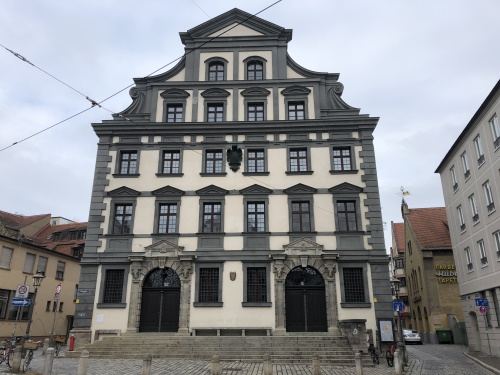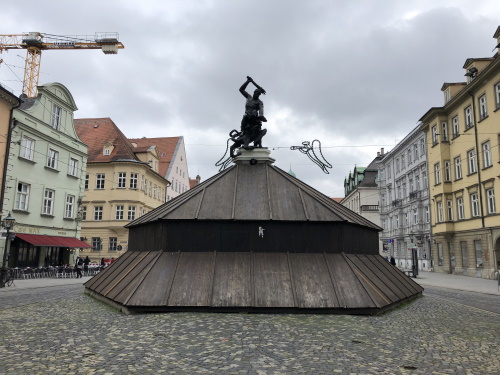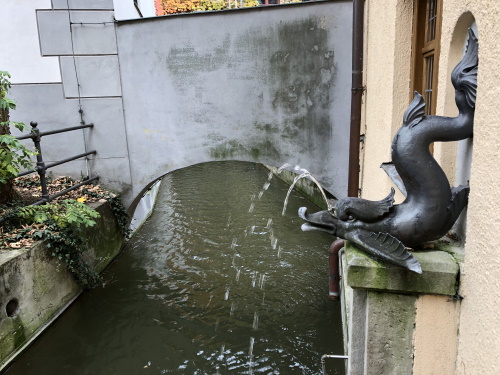Blog WHS Visits
WHS #725: Augsburg
I wasn’t terribly interested in the Water Management System of Augsburg, but I did feel an urgent need to make my German WHS score ‘complete’ again! So last Saturday I ventured out to this Bavarian city on a day trip from my home – flying Amsterdam-Munich and then taking a train to Augsburg. Even for an experienced traveler and German speaker, buying a train ticket from a vending machine proved to be like finishing a moderately difficult exam, having to answer question after question – resulting in a final bill of 50.90 EUR for the return trip Munich Airport - Augsburg. Ouch!
So this day consisted of a lot of sitting in planes and trains. The stay was to be so short that I did not even bring a bag and only kept my iPhone in a coat pocket. No passport as well; since a few months I am using only a creditcard sized ID card for travels within the EU (which feels a bit like having a second passport, so the real one can be safely sent to some embassy for a visa). The iPhone fortunately gave me access to some good podcasts. I recently started listening to the Counting Countries series, so while I was physically in Germany my mind wandered off to Tajikistan and Niger.
From Augsburg railway station you can walk to the historic city center in 15 minutes. You pass through shopping streets, where it was pleasantly busy and perhaps only the cheap level of the shops and restaurants stood out (such as the many Dönerkebab and McDonalds restaurants). Augsburg however was a very rich city in the 17th century. The most important buildings in the center date from that time. Fortunately I had memorized the names of some of the 22 inscribed components, a casual visitor would just walk past by them. Nowhere I found an indication that there is a WHS hiding in here.
My first stop was at the Stadtmetzg , the beautiful gray building shown in photo #1. This was the central place in the city where meat was carved, stored and sold. It is linked to the water management system because it functioned in an especially hygienic way for its time. Channels ran underneath that provided the supply of clean water for use and the removal of waste water.
Augsburg's city center is especially known for three monumental fountains. They were constructed (from 1585 on) in connection with the anniversary of the foundation of the city 1600 years before and represented the abundance of water in the city. They did look a little strange now, in November, as they were shielded with wooden covers to protect them from freezing in the upcoming winter. Only the statues at the top of the fountain still protruded.
The Red Tower lies a bit outside of the central area. It is a remnant of a gate in the old city wall. Next to this gate lies a set of buildings that are said to be the oldest remaining waterworks in Central Europe. From 1416 onwards, they provided drinking water to the city for over 400 years. Visible are two high water towers, the house of the Brunnenmeister (the master well digger?) and something that now looks like an insignificant canal.
It is very unfortunate that the city of Augsburg has done little about the interpretation of the WHS components. Yes, there a signs next to the components with a short accompanying text. But most parts are not accessible at all (historic interiors often not having been preserved), or only with a special tour that is not conducted in the winter months. What remains is a typical southern German city with narrow canals that cannot stand in the shadow of those in Amsterdam or Bruges.
I further fully agree with Matejicek’s review that this is a WHS that may have looked good on paper and convinced the ‘judges’ that way. The reality on the ground is much different. The core zone is questionable as well – looking at the map it covers a huge area (the flow of the canals, partly underground), while it easily could have been limited to the 22 named components as a serial nomination.
Els - 17 November 2019
Comments
Jay T 17 November 2019
Ah, yes — boarded up fountains; I saw plenty of those across Germany when I visited last March. That’s a downside to visiting in the off-season. I’ll have to be sure to see Augsburg in the summer when I visit some day. Thanks for the review!


